The Differences in Water Consumption Between Pinus and Salix in the Mu Us Sandy Land, a Semiarid Region of Northwestern China
Abstract
1. Introduction
2. Study Area and Methods
2.1. Study Area
2.2. In Situ Experiments
2.3. Isotopic Sample Determination
2.3.1. Water Sample Collection from Different Vegetation Plots
2.3.2. Water Isotope Extraction and Determination
2.3.3. Bayesian Mixing Model MixSIAR
3. Results
3.1. Dynamics of Major Meteorological Elements
3.2. Evolution Characteristics of Groundwater
3.3. Temporal and Spatial Distribution Characteristics of Soil Water
3.4. Water Isotopic Composition of Vegetation Xylem
3.5. Contribution of Different Water Sources to Vegetation Water Consumption
4. Discussion
4.1. Water Consumption Characteristics of Pinus and Salix
4.2. The Difference in Water Consumption Between Exotic Artificial Vegetation and the Local Native Vegetation
4.3. Implications for Vegetation Restoration Management
4.4. Limitations and Future Prospects
5. Conclusions
Author Contributions
Funding
Data Availability Statement
Acknowledgments
Conflicts of Interest
References
- Sun, S.; Xiang, W.; Ouyang, S.; Hu, Y.; Peng, C. Balancing Water Yield and Water Use Efficiency Between Planted and Natural Forests: A Global Analysis. Glob. Change Biol. 2024, 30, e17561. [Google Scholar] [CrossRef]
- Lan, Z.; Zhang, S.; Tanveer, A.; Wu, L.; Chang, W.; Li, X.; Zhang, J.; Fan, J. Fine-scale spatial distribution of soil organic carbon and its fractions after afforestation with Pinus sylvestris and Salix psammophila in a semiarid desert of China. J. Plant Ecol. 2021, 1, 141–154. [Google Scholar]
- Deng, J.; Yao, J.; Zheng, X.; Gao, G. Transpiration and canopy stomatal conductance dynamics of Mongolian pine plantations in semiarid deserts, Northern China. Agric. Water Manag. 2021, 249, 106806. [Google Scholar] [CrossRef]
- Nan, W.; Ta, F.; Meng, X.; Dong, Z.; Xiao, N. Effects of age and density of Pinus sylvestris var. mongolica on soil moisture in the semiarid Mu Us Dunefield, northern China. For. Ecol. Manag. 2020, 473, 118313. [Google Scholar] [CrossRef]
- Huang, J.; Li, Y.; Fu, C.; Chen, F.; Fu, Q.; Dai, A.; Shinoda, M.; Ma, A.; Guo, W.; Li, Z.; et al. Dryland climate change: Recent progress and challenges. Rev. Geophys. 2017, 55, 719–778. [Google Scholar] [CrossRef]
- Huang, L.; Shao, M. Advances and perspectives on soil water research in China’s loess plateau. Earth-Sci. Rev. 2019, 199, 102962. [Google Scholar] [CrossRef]
- Dai, J.; Li, Y.; Wang, L. Mixed-species plantations alleviate deep soil water depletion and facilitate hydrological niche partitioning compared to pure plantations. For. Ecol. Manag. 2023, 539, 121017. [Google Scholar] [CrossRef]
- Blicharska, M.; Smithers, R.; Mikusiński, G.; Rönnbäck, P.; Harrison, P.; Nilsson, M.; Sutherland, W. Biodiversity’s contributions to sustainable development. Nat. Sustain. 2019, 2, 1083–1093. [Google Scholar] [CrossRef]
- Sun, G.; Zhou, G.; Zhang, A.; Wei, X.; McNulty, S.; Vose, J. Potential water yield reduction due to forestation across China. J. Hydrol. 2006, 328, 548–558. [Google Scholar] [CrossRef]
- Shao, M.; Wang, Y.; Xia, Y.; Jia, X. Soil drought and water carrying capacity for vegetation in the critical zone of the Loess Plateau: A review. Vadose Zone J. 2018, 17, 1–8. [Google Scholar] [CrossRef]
- Wang, L.; Wang, Q.; Wei, S.; Shao, M.; Li, Y. Soil desiccation for Loess soils on natural and regrown areas. For. Ecol. Manag. 2008, 255, 2467–2477. [Google Scholar] [CrossRef]
- Farley, K.; Jobbágy, E.; Jackson, R. Effects of afforestation on water yield: A global synthesis with implications for policy. Glob. Change Biol. 2005, 11, 1565–1576. [Google Scholar] [CrossRef]
- Zhao, M.; Wang, W.; Wang, Z.; Chen, L.; Ma, Z.; Wang, Q. Water use of Salix in the variably unsaturated zone of a semiarid desert region based on in-situ observation. J. Hydrol. 2020, 591, 125579. [Google Scholar] [CrossRef]
- Jiao, J.R. Implementation and policy execution of removal lands from cultivation for afforestation project in the northwestern areas. Sci. Soil Water Conserv. 2005, 3, 4–9. [Google Scholar]
- Shen, Y.; Yang, Q.; Jing, K.; Xu, J. Thoughts and proposals on speeding up water and soil conservation and ecological environment construction on the Loess Plateau. Sci. Technol. Rev. 2003, 4, 55–59. [Google Scholar]
- Wang, X.; Lu, C.; Fang, J.; Shen, Y. Implications for development of grain-for-green policy based on cropland suitability evaluation in desertification-affected north China. Land Use Policy 2007, 24, 417–424. [Google Scholar] [CrossRef]
- Zhang, Q.; Xu, C.Y.; Yang, T. Variability of water resource in the Yellow River basin of past 50 years, China. Water Resour. Manag. 2009, 23, 1157–1170. [Google Scholar] [CrossRef]
- Zhou, H.; Van Rompaey, A.; Wang, J.A. Detecting the impact of the Grain for Green program on the mean annual vegetation cover in the Shaanxi province, China using SPOT-VGT NDVI data. Land Use Policy 2009, 26, 954–960. [Google Scholar] [CrossRef]
- Cao, S.; Chen, L.; Shankman, D.; Wang, C.; Wang, X.; Zhang, H. Excessive reliance on afforestation in China’s arid and semi-arid regions: Lessons in ecological restoration. Earth Sci. Rev. 2011, 104, 240–245. [Google Scholar] [CrossRef]
- Jiao, J.; Tzanopoulos, J.; Xofis, P.; Bai, W.; Ma, X.; Mitchley, J. Can the study of natural vegetation succession assist in the control of soil erosion on abandoned croplands on the Loess Plateau, China. Restor. Ecol. 2007, 15, 391–399. [Google Scholar] [CrossRef]
- Oki, T.; Kanae, S. Global hydrological cycles and world water resources. Science 2006, 313, 1068–1072. [Google Scholar] [CrossRef]
- Knighton, J.; Kuppel, S.; Smith, A.; Soulsby, C.; Sprenger, M.; Tetzlaff, D. Using isotopes to incorporate tree water storage and mixing dynamics into a distributed ecohydrologic modelling framework. Ecohydrology 2020, 13, e2201. [Google Scholar] [CrossRef]
- Knighton, J.; Singh, K.; Evaristo, J. Understanding catchment-scale forest root water uptake strategies across the continental United States through inverse ecohydrological modeling. Geophys. Res. Lett. 2020, 47, e2019GL085937. [Google Scholar] [CrossRef]
- Good, S.; Noone, D.; Bowen, G. Hydrologic connectivity constrains partitioning of global terrestrial water fluxes. Science 2015, 349, 175–177. [Google Scholar] [CrossRef] [PubMed]
- Schlesinger, W.; Jasechko, S. Transpiration in the global water cycle. Agric. For. Meteorol. 2014, 189, 115–117. [Google Scholar] [CrossRef]
- Liu, Z.; Yu, X.; Jia, G. Water utilization characteristics of typical vegetation in the rocky mountain area of Beijing, China. Ecol. Indic. 2018, 91, 249–258. [Google Scholar] [CrossRef]
- Pei, Y.; Huang, L.; Shao, M.; Jia, X.; Tang, X.; Zhang, Y.; Pan, Y. Water sources used by artificial Salix psammophila in stands of different ages based on stable isotope analysis in northeastern Mu Us Sandy Land. Catena 2023, 226, 107087. [Google Scholar] [CrossRef]
- Zhao, Y.; Wang, L.; Knighton, J.; Evaristo, J.; Wassen, M. Contrasting adaptive strategies by Caragana korshinskii and Salix psammophila in a semiarid revegetated ecosystem. Agric. For. Meteorol. 2021, 300, 108323. [Google Scholar] [CrossRef]
- Yang, B.; Wen, X.; Sun, X. Seasonal variations in depth of water uptake for a subtropical coniferous plantation subjected to drought in an East Asian monsoon region. Agric. For. Meteorol. 2015, 200, 218–228. [Google Scholar] [CrossRef]
- Pei, Y.; Huang, L.; Shao, M.; Zhang, Y.; Pan, Y. Water use pattern and transpiration of Mongolian pine plantations inrelation to stand age on northern Loess Plateau of China. Agric. For. Meteorol. 2023, 330, 109320. [Google Scholar] [CrossRef]
- Zhao, M.; Wang, W.; Ma, Z.; Wang, Q.; Wang, Z.; Chen, L.; Fu, B. Soil water dynamics based on a contrastive experiment between vegetated and non-vegetated sites in a semiarid region in Northwest China. J. Hydrol. 2021, 603, 126880. [Google Scholar] [CrossRef]
- Huo, G.; Zhao, X.; Gao, X.; Wang, S.; Pan, Y. Seasonal water use patterns of rainfed jujube trees in stands of different ages under semiarid plantations in China. Agric. Ecosyst. Environ. 2018, 265, 392–401. [Google Scholar] [CrossRef]
- Wang, J.; Fu, B.; Lu, N.; Zhang, L. Seasonal variation in water uptake patterns of three plant species based on stable isotopes in the semi-arid loess plateau. Sci. Total Environ. 2017, 609, 27–37. [Google Scholar] [CrossRef] [PubMed]
- Eggemeyer, K.; Awada, T.; Harvey, F.; Wedin, D.; Zhou, X.; Zanner, C. Seasonal changes in depth of water uptake for encroaching trees Juniperus virginiana and Pinus ponderosa and two dominant C4 grasses in a semiarid grassland. Tree Physiol. 2009, 29, 157–169. [Google Scholar] [CrossRef]
- Rothfuss, Y.; Javaux, M. Reviews and syntheses: Isotopic approaches to quantify root water uptake: A review and comparison of methods. Biogeosciences 2017, 14, 2199–2224. [Google Scholar] [CrossRef]
- Li, L.; Liu, H.; Zhao, W.; Guo, L.; Liu, J.; Zhou, H.; Su, Y.; Yetemen, O. Application of water-stable isotopes in quantitative identification of groundwater-dependent vegetations: A soil sampling strategy. J. Hydrol. 2025, 657, 133074. [Google Scholar] [CrossRef]
- Zhang, C.; Ren, Y.; Yan, M.; Sang, T.; Li, H.; Chen, Y.; Zhang, S. Stable isotopes δ18O and δ2H reveal differential water uptake from intercropped maize and soybean soil profiles. Field Crops Res. 2022, 288, 108695. [Google Scholar] [CrossRef]
- Song, Y.; Yan, D.; Liu, T.; Lu, Y.; Jiao, R.; Wen, Y.; Qin, T.; Weng, B.; Shi, W. The suitability of isotopic methods in identifying water sources of a shallow-rooted herbaceous plant in a desert steppe. Sci. Total Environ. 2023, 902, 166072. [Google Scholar] [CrossRef]
- Li, Y.; Ma, Y.; Song, X.; Wang, L.; Han, D. A δ2H offset correction method for quantifying root water uptake of riparian trees. J. Hydrol. 2021, 593, 125811. [Google Scholar] [CrossRef]
- Tong, X.; Zhang, J.; Meng, P.; Li, J.; Zheng, N. Ecosystem water use efficiency in a warm-temperate mixed plantation in the North China. J. Hydrol. 2014, 512, 221–228. [Google Scholar] [CrossRef]
- Hua, F.; Wang, X.; Zheng, X.; Fisher, B.; Wang, L.; Zhu, J.; Tang, Y.; Yu, D.; Wilcove, D. Opportunities for biodiversity gains under the world’s largest reforestation programme. Nat. Commun. 2016, 7, 12717. [Google Scholar] [CrossRef]
- Wu, J.; Liu, W.; Chen, C. How do plants share water sources in a rubber-tea agroforestry system during the pronounced dry season? Agric. Ecosyst. Environ. 2017, 236, 69–77. [Google Scholar] [CrossRef]
- Brum, M.; Vadeboncoeur, M.; Ivanov, V.; Asbjornsen, H.; Saleska, S.; Alves, L.; Penha, D.; Dias, L.; Aragão, L.; Barros, F.; et al. Hydrological niche segregation defines forest structure and drought tolerance strategies in a seasonal Amazon forest. J. Ecol. 2019, 107, 318–333. [Google Scholar] [CrossRef]
- Zhang, S.; Wang, X.; Huang, Z.; Bao, Y.; Jiang, J.; Liu, Z. Quercus acutissima exhibits more adaptable water uptake patterns in response to seasonal changes compared to Pinus massoniana. For. Ecosyst. 2025, 12, 100255. [Google Scholar] [CrossRef]
- Ma, L.; Ma, J.; Yan, P.; Tian, F.; Peñuelas, J.; Rao, M.; Fu, Y.; Hu, Z. Planted Forests in China Have Higher Drought Risk Than Natural Forests. Glob. Change Biol. 2025, 31, e70055. [Google Scholar] [CrossRef] [PubMed]
- Chen, Y.; Zha, T.; Zhang, H.; Zhao, L.; Wang, A.; Cui, Q.; Song, J.; Zhang, H.; Yu, Y.; Wang, D. Typical Plantation Water Use Strategies Are Determined by Environmental Conditions and Plant Eco-Physiology in Beijing, China. Forests 2023, 14, 2277. [Google Scholar] [CrossRef]
- Pei, Y.; Huang, L.; Shao, M.; Wang, J.; Zhang, Y. Patterns and drivers of seasonal water sources of artificial sand-fixing plants in the northeastern Mu Us Sandy Land. Pedosphere 2023, 34, 63–77. [Google Scholar] [CrossRef]
- Gao, X.; Zhao, X.; Li, H.; Guo, L.; Lv, T.; Wu, P. Exotic shrub species (Caragana korshinskii) is more resistant to extreme natural drought than native species (Artemisia gmelinii) in a semiarid revegetated ecosystem. Agric. For. Meteorol. 2018, 263, 207–216. [Google Scholar] [CrossRef]
- Tong, Y.; Liu, J.; Han, X.; Zhang, T.; Dong, Y.; Wu, M.; Qin, S.; Wei, Y.; Chen, Z.; Zhou, Y. Radial and seasonal variation of sap flow and its response to meteorological factors in sandy Pinus sylvestris var. mongolica plantations in the Three North Shelterbelt of China. Agric. For. Meteorol. 2023, 328, 109239. [Google Scholar] [CrossRef]
- Chen, B.; Liu, S.; Yu, J.; Huang, Y.; Yu, S.; Liu, H.; Zhang, T.; Liu, X.; Jin, G.; Chen, W.; et al. Stand Biomass of Pinus sylvestris var. mongolica Plantations Benefits from High Density Monocultures in the Boreal Zone. For. Ecosyst. 2024, 11, 100222. [Google Scholar] [CrossRef]
- Stock, B.; Semmens, B. MixSIAR GUI User Manual. Version 3.1. 2013. Available online: https://CRAN.R-project.org/package=MixSIAR (accessed on 10 August 2025).
- Adiku, S.; Rose, C.; Braddock, R.; Lafontaine, H. On the simulation of root water extraction: Examination of a minimum energy hypothesis. Soil Sci. 2000, 165, 226–236. [Google Scholar] [CrossRef]
- Hasselquist, N.; Allen, M. Increasing demands on limited water resources: Consequences for two endangered plants in Amargosa Valley, USA. Am. J. Bot. 2009, 96, 620–626. [Google Scholar] [CrossRef] [PubMed]
- Song, L.; Zhu, J.; Li, M.; Zhang, J.; Lv, L. Sources of water used by Pinus sylvestris var. mongolica trees based on stable isotope measurements in a semiarid sandy region of Northeast China. Agric. Water Manag. 2016, 164, 281–290. [Google Scholar] [CrossRef]
- Song, L.; Zhu, J.; Li, M.; Zhang, J. Water use patterns of Pinus sylvestris var. mongolica trees of different ages in a semiarid sandy lands of Northeast China. Environ. Exp. Bot. 2016, 129, 94–107. [Google Scholar] [CrossRef]
- Brinkmann, N.; Seeger, S.; Weiler, M.; Buchmann, N.; Eugster, W.; Kahmen, A. Employing stable isotopes to determine the residence times of soil water and the temporal origin of water taken up by Fagus sylvatica and Picea abies in a temperate forest. New Phytol. 2018, 219, 1300–1313. [Google Scholar] [CrossRef]
- Huang, L.; Zhang, Z. Stable isotopic analysis on water utilization of two xerophytic shrubs in a revegetated desert area: Tengger Desert, China. Water 2015, 7, 1030–1045. [Google Scholar] [CrossRef]
- Wang, L.; Mu, Y.; Zhang, Q.; Zhang, X. Groundwater use by plants in a semi-arid coal-mining area at the Mu Us Desert frontier. Environ. Earth Sci. 2013, 69, 1015–1024. [Google Scholar]
- Huang, J.; Zhou, Y.; Wenninger, J.; Ma, H.; Zhang, J.; Zhang, D. How water use of Salix psammophila bush depends on groundwater depth in a semi-desert area. Environ. Earth Sci. 2016, 75, 1–13. [Google Scholar] [CrossRef]
- Pei, Y.; Huang, L.; Shao, M.; Zhang, Y. Responses of Amygdalus pedunculata Pall. to water stress in sandy and loamy soils. J. Arid Land 2020, 12, 791–805. [Google Scholar]
- Song, L.; Zhu, J.; Zheng, X.; Wang, K.; Lü, L.; Zhang, X.; Hao, G. Transpiration and canopy conductance dynamics of Pinus sylvestris var. mongolica in its natural range and in an introduced region in the sandy plains of Northern China. Agric. For. Meteorol. 2020, 281, 107830. [Google Scholar] [CrossRef]
- Karnieli, A.; Gilad, U.; Ponzet, M.; Svoray, T.; Mirzadinov, R.; Fedorina, O. Assessing land-cover change and degradation in the Central Asian deserts using satellite image processing and geostatistical methods. J. Arid Environ. 2008, 72, 2093–2105. [Google Scholar] [CrossRef]
- Liu, S.; Bai, J.; Jia, Z.; Jia, L. Estimation of evapotranspiration in the Mu Us Sand land of China. Hydrol. Earth Syst. Sci. 2010, 14, 573–584. [Google Scholar] [CrossRef]
- Li, X.; Zhang, Z.; Huang, L.; Wang, X. Review of the ecohydrological processes and feedback mechanisms controlling sand-binding vegetation systems in sandy desert regions of China. Chin. Sci. Bull. 2013, 58, 1483–1496. [Google Scholar] [CrossRef]
- Asadalla, N.; Abdullah, M.; Al-Ali, Z.; Abdullah, M. Vegetation restoration targeting approach to identify the optimum environmental conditions for the restoration of native desert plants using remote sensing and MaxEnt modeling. Restor. Ecol. 2021, 29, e13425. [Google Scholar] [CrossRef]
- Halik, Ü.; Aishan, T.; Betz, F.; Kurban, A.; Rouzi, A. Effectiveness and challenges of ecological engineering for desert riparian forest restoration along China’s largest inland river. Ecol. Eng. 2019, 127, 11–22. [Google Scholar] [CrossRef]
- Sun, Z.; Mao, Z.; Yang, L.; Liu, Z.; Han, J.; Wang, H.; He, W. Impacts of climate change and afforestation on vegetation dynamic in the Mu Us Desert, China. Ecol. Indic. 2021, 129, 108020. [Google Scholar] [CrossRef]
- Luo, L.; Zhuang, Y.; Zhao, W.; Duan, Q.; Wang, L. The hidden costs of desert development. Ambio 2020, 49, 1412–1422. [Google Scholar] [CrossRef]
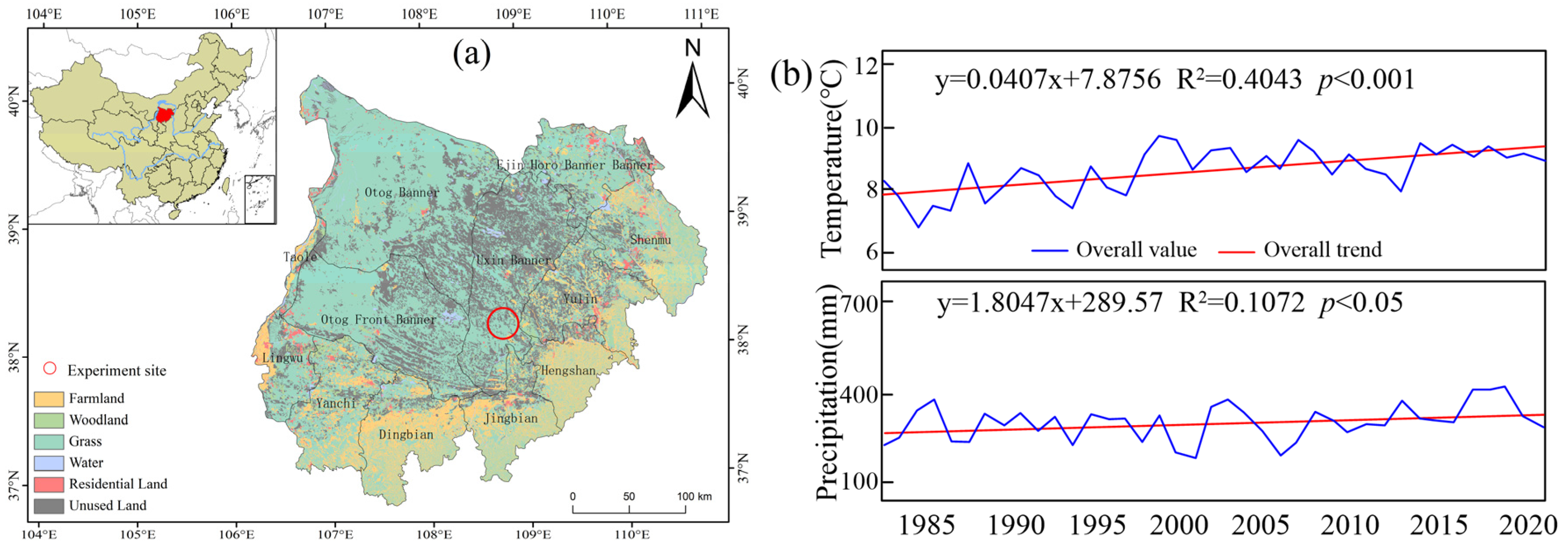
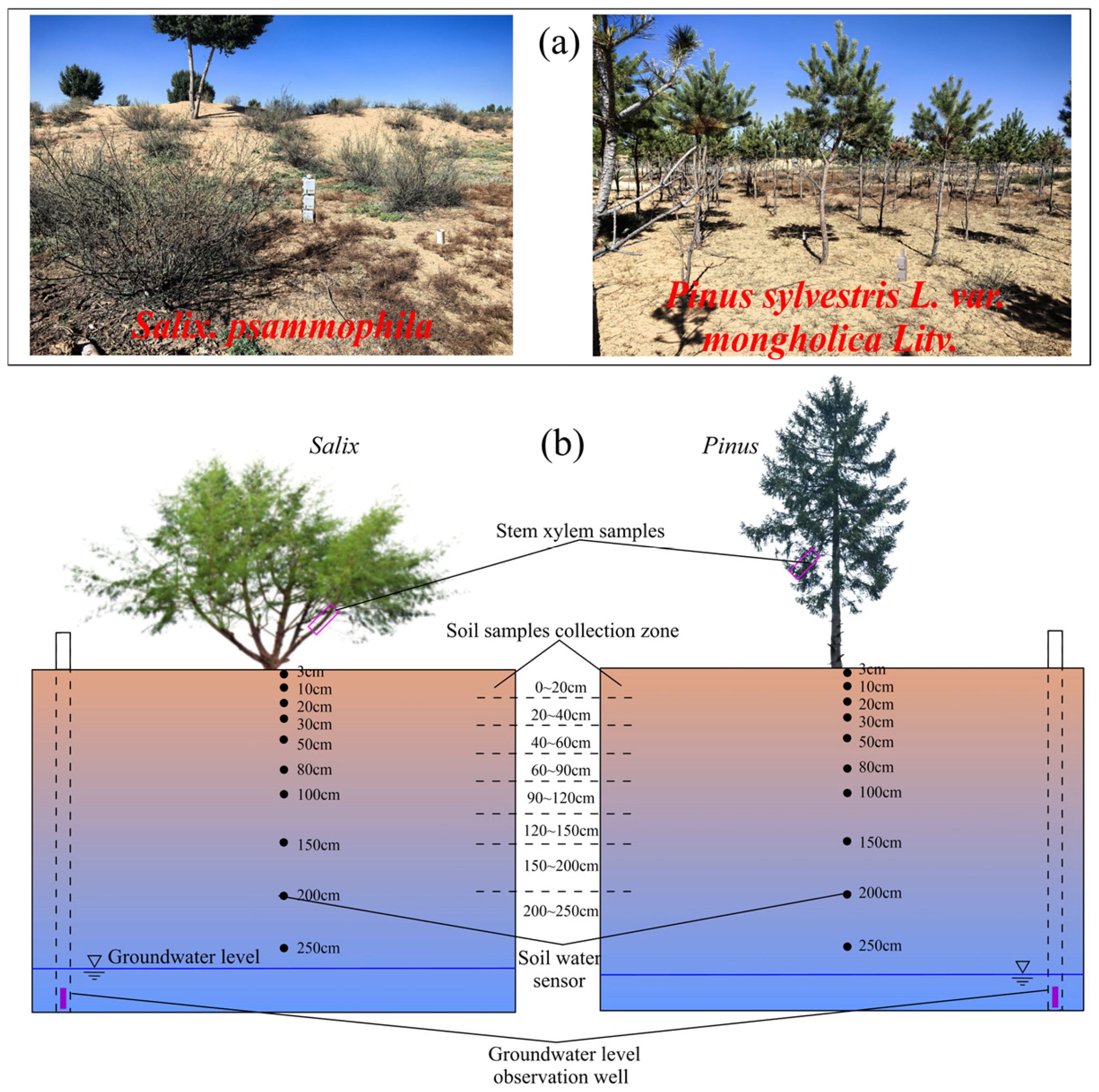

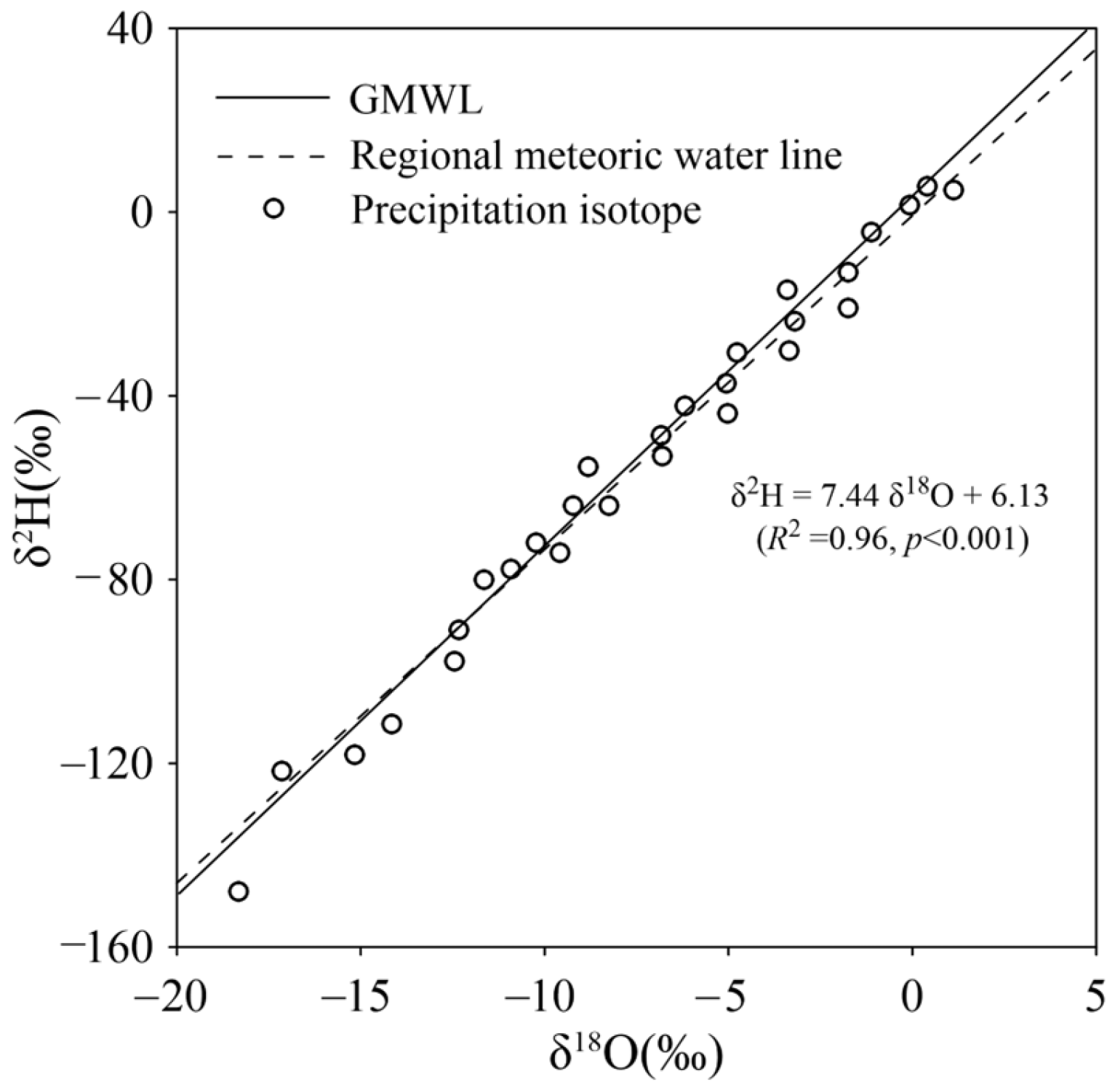
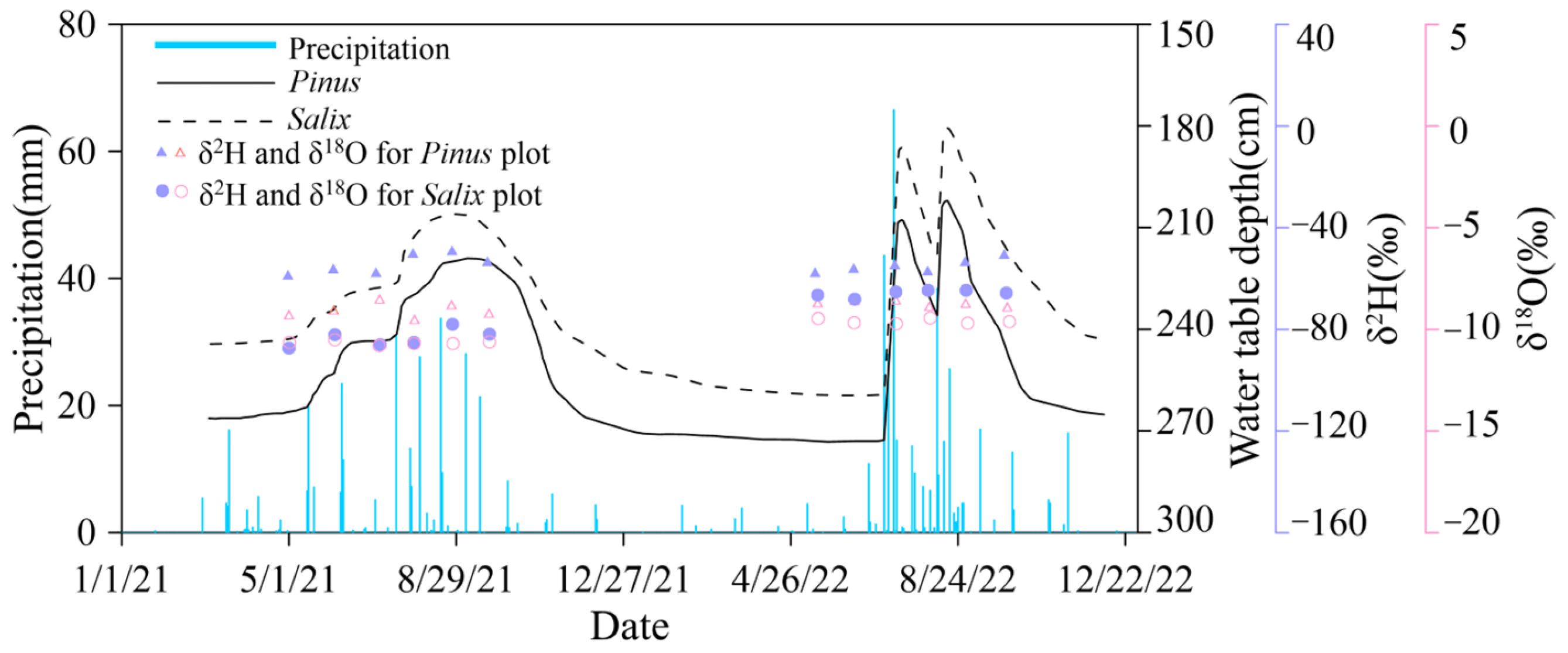
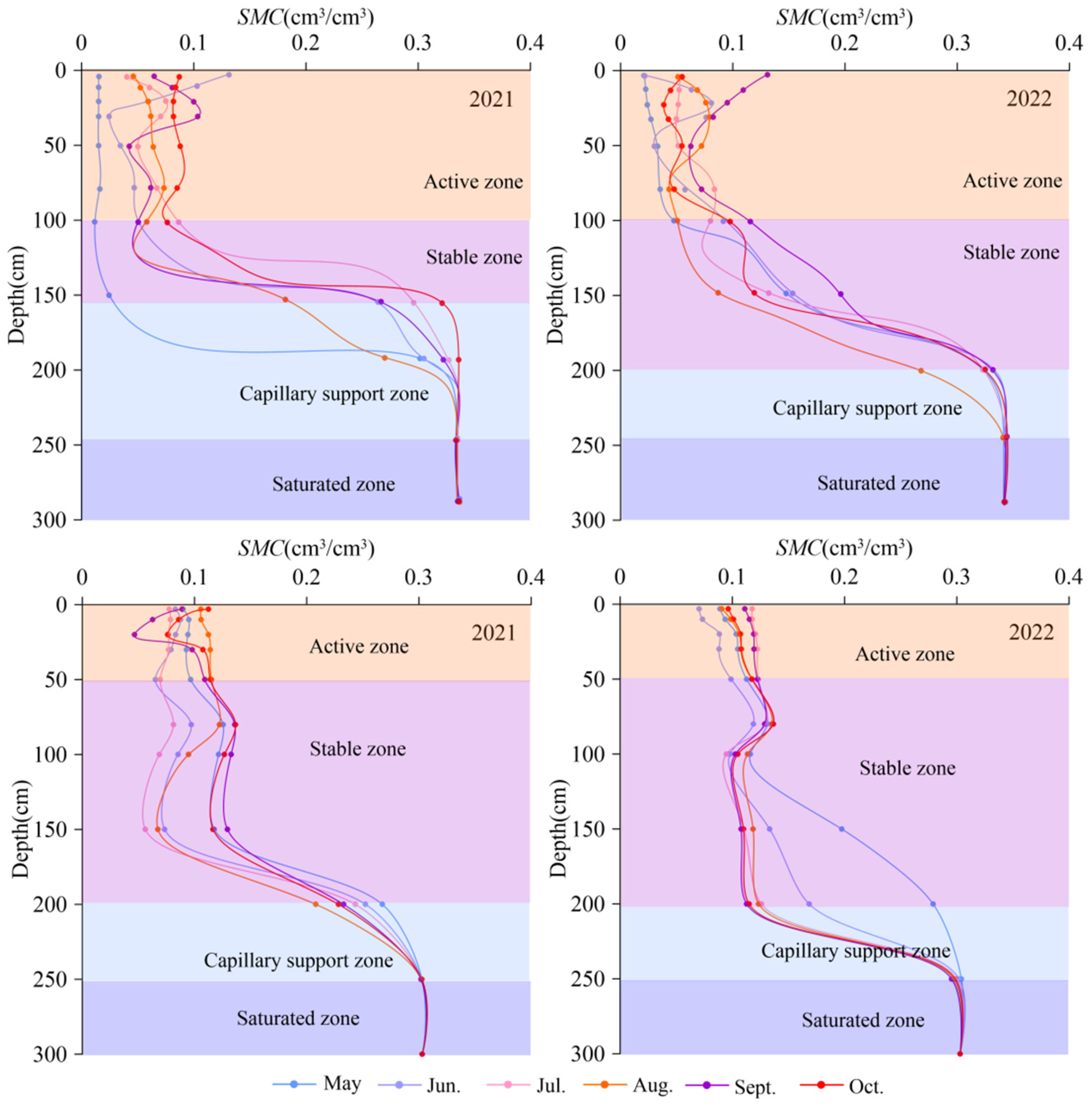

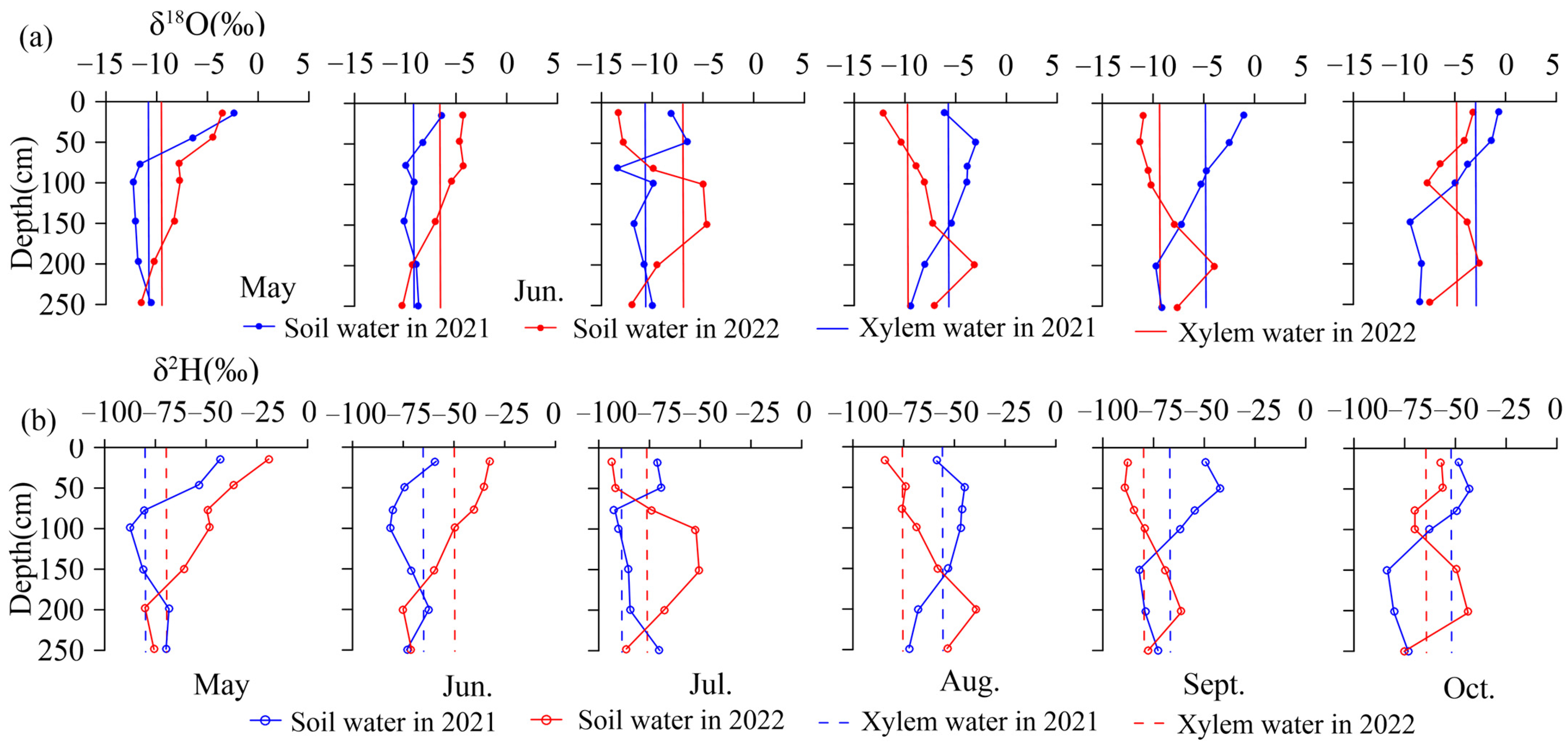
| Particle Composition | Hydraulic Parameters | |||||||
|---|---|---|---|---|---|---|---|---|
| Particle size (mm) | Dry density (g/cm3) | Residual soil moisture content (θr) (cm3/cm3) | Saturated soil moisture content (θs) (cm3/cm3) | a (cm−1) | n | Ks (cm/d) | ||
| 0.05~ 0.25 | 0.25~ 0.075 | 0.075 ~0.05 | ||||||
| 5.7% | 87.7% | 5.6% | 1.47 | 0.021 | 0.332 | 0.036 | 2.44 | 578 |
| Year | Month | Active Zone (%) | Stable Zone (%) | Capillary Support Zone (%) | Saturation Zone (%) |
|---|---|---|---|---|---|
| 2021 | May | 9.2 ± 3.1% | 10.7 ± 4.0% | 31.6 ± 7.2% | 48.5 ± 5.5% |
| June | 19.4 ± 4.0% | 21.1 ± 1.0% | 20.7 ± 4.1% | 38.8 ± 3.3% | |
| July | 28.5 ± 1.4% | 20.7 ± 2.5% | 22.9 ± 1.0% | 27.9 ± 2.0% | |
| August | 29.9 ± 2.1% | 40.3 ± 1.4% | 19.7 ± 2.7% | 10.1 ± 3.4% | |
| September | 19.3 ± 1.8% | 26.7 ± 2.6% | 33.3 ± 3.1% | 20.7 ± 2.1% | |
| October | 20.0 ± 2.5% | 27.6 ± 1.5% | 32.9 ± 1.8% | 19.5 ± 1.3% | |
| Annual average | 21.1 ± 3.7% | 24.5 ± 2.8% | 26.9 ± 4.5% | 27.5 ± 3.5% | |
| 2022 | May | 3.1 ± 2.6% | 10.1 ± 5.1% | 26.7 ± 3.6% | 60.1 ± 3.8% |
| June | 18.2 ± 3.3% | 17.2 ± 3.6% | 7.3 ± 2.3% | 57.3 ± 4.2% | |
| July | 17.9 ± 1.8% | 13.3 ± 3.3% | 18.8 ± 2.1% | 50.0 ± 1.7% | |
| August | 22.2 ± 1.4% | 20.3 ± 1.3% | 27.2 ± 3.0% | 30.3 ± 1.1% | |
| September | 21.4 ± 2.0% | 22.1 ± 2.2% | 28.4 ± 1.5% | 28.1 ± 2.4% | |
| October | 12.3 ± 2.1% | 20.0 ± 2.1% | 37.4 ± 1.8% | 30.3 ± 1.0% | |
| Annual average | 15.9 ± 3.4% | 17.2 ± 3.2% | 24.3 ± 3.6% | 42.6 ± 3.2% | |
| Two-year average | 18.5 ± 3.8% | 20.9 ± 3.1% | 25.6 ± 3.7% | 35.0 ± 3.4% | |
| Year | Month | Active Zone (%) | Stable Zone (%) | Capillary Support Zone (%) | Saturation Zone (%) |
|---|---|---|---|---|---|
| 2021 | May | 17.7 ± 4.7% | 29.9 ± 6.1% | 23.1 ± 2.8% | 29.3 ± 1.5% |
| June | 18.4 ± 1.1% | 32.6 ± 2.7% | 24.6 ± 1.7% | 24.4 ± 1.6% | |
| July | 21.0 ± 5.4% | 29.5 ± 1.9% | 25.9 ± 3.3% | 23.6 ± 0.8% | |
| August | 28.3 ± 1.7% | 25.8 ± 2.4% | 21.4 ± 1.6% | 24.5 ± 1.1% | |
| September | 32.2 ± 3.8% | 22.9 ± 5.1% | 25.2 ± 1.6% | 19.7 ± 1.2% | |
| October | 43.5 ± 2.9% | 24.1 ± 2.4% | 20.3 ± 2.0% | 12.1 ± 1.6% | |
| Annual average | 26.9 ± 3.3% | 27.4 ± 3.7% | 23.4 ± 2.9% | 22.3 ± 1.5% | |
| 2022 | May | 18.1 ± 5.0% | 17.8 ± 3.0% | 23.0 ± 1.8% | 41.1 ± 2.3% |
| June | 38.2 ± 4.1% | 21.3 ± 2.6% | 18.3 ± 2.8% | 22.2 ± 1.7% | |
| July | 31.0 ± 1.7% | 31.2 ± 4.6% | 16.0 ± 1.7% | 21.8 ± 2.0% | |
| August | 42.9 ± 2.2% | 23.8 ± 4.5% | 18.9 ± 2.4% | 14.1 ± 1.4% | |
| September | 21.4 ± 3.1% | 24.0 ± 1.3% | 40.8 ± 1.0% | 13.8 ± 1.1% | |
| October | 40.3 ± 3.7% | 20.2 ± 2.6% | 25.5 ± 1.5% | 14.0 ± 1.7% | |
| Annual average | 32.0 ± 3.6% | 23.1 ± 4.1% | 23.7 ± 2.8% | 21.2 ± 2.2% | |
| Two-year average | 29.4 ± 3.5% | 25.3 ± 4.0% | 23.6 ± 3.0% | 21.7 ± 2.4% | |
Disclaimer/Publisher’s Note: The statements, opinions and data contained in all publications are solely those of the individual author(s) and contributor(s) and not of MDPI and/or the editor(s). MDPI and/or the editor(s) disclaim responsibility for any injury to people or property resulting from any ideas, methods, instructions or products referred to in the content. |
© 2025 by the authors. Licensee MDPI, Basel, Switzerland. This article is an open access article distributed under the terms and conditions of the Creative Commons Attribution (CC BY) license (https://creativecommons.org/licenses/by/4.0/).
Share and Cite
Zhao, M.; Fang, J.; Huang, J.; Lei, D.; Xing, Z. The Differences in Water Consumption Between Pinus and Salix in the Mu Us Sandy Land, a Semiarid Region of Northwestern China. Water 2025, 17, 2895. https://doi.org/10.3390/w17192895
Zhao M, Fang J, Huang J, Lei D, Xing Z. The Differences in Water Consumption Between Pinus and Salix in the Mu Us Sandy Land, a Semiarid Region of Northwestern China. Water. 2025; 17(19):2895. https://doi.org/10.3390/w17192895
Chicago/Turabian StyleZhao, Ming, Jie Fang, Jianhui Huang, Da Lei, and Zhenguo Xing. 2025. "The Differences in Water Consumption Between Pinus and Salix in the Mu Us Sandy Land, a Semiarid Region of Northwestern China" Water 17, no. 19: 2895. https://doi.org/10.3390/w17192895
APA StyleZhao, M., Fang, J., Huang, J., Lei, D., & Xing, Z. (2025). The Differences in Water Consumption Between Pinus and Salix in the Mu Us Sandy Land, a Semiarid Region of Northwestern China. Water, 17(19), 2895. https://doi.org/10.3390/w17192895






